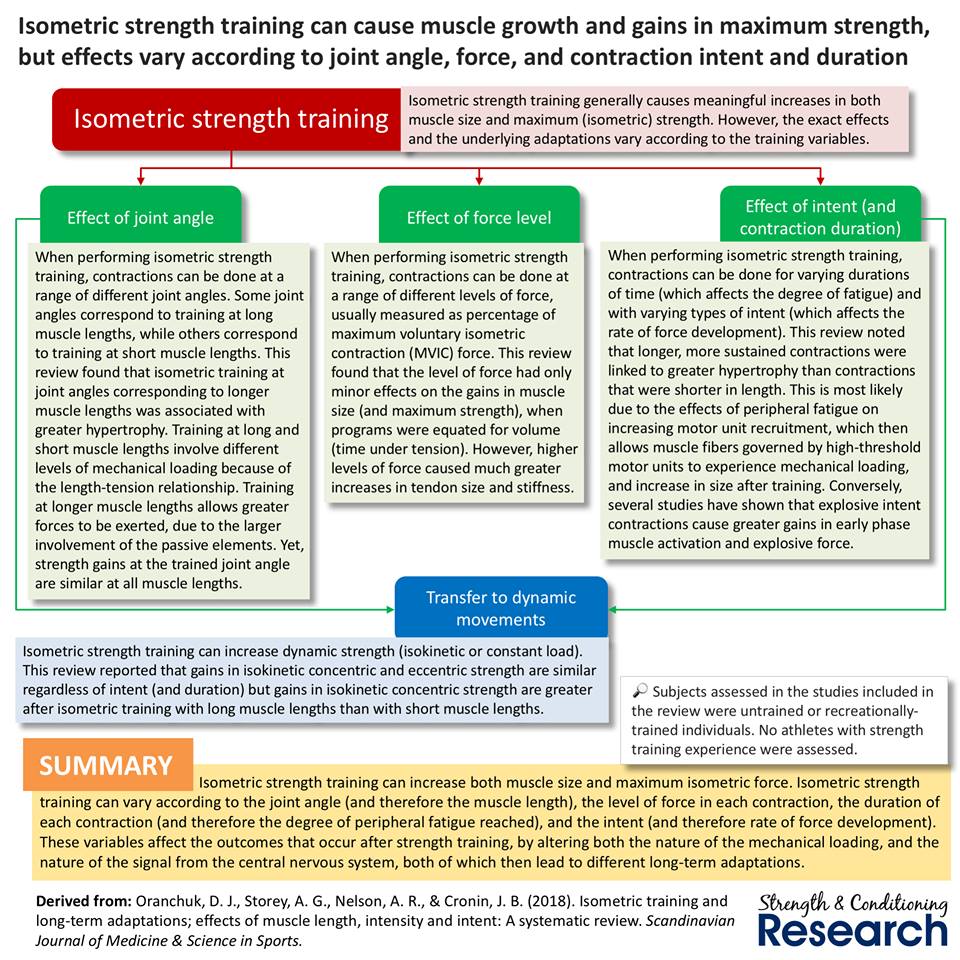cool study, here are a few more...
Relative changes in maximal force, EMG, and muscle cross-sectional area after isometric training.
Garfinkel S, Cafarelli E.
Department of Physical Education, Faculty of Pure and Applied Science, York University, Toronto, Ontario, Canada.
The purpose of this experiment was to determine whether training-induced increases in maximal voluntary contraction (MVC) can be completely accounted for by increases in muscle cross-sectional area. Fifteen female university students were randomly divided into a control (N = 7) and an experimental (N = 8) group. The experimental group underwent 8 wk of isometric resistance training of the knee extensors of one leg; the other leg was the untrained control. Training consisted of 30 MVC.d-1 x 3 d.wk-1 x 8 wk. Extensor cross-sectional area (CSA), assessed by computerized tomographic (CT) scanning of a cross-sectional slice at mid-thigh, was used as a measure of muscle hypertrophy. After 8 wk of training, MVC increased by 28% (P < 0.05), CSA increased by 14.6% (P < 0.05), and the amplitude of the electromyogram at MVC (EMGmax) was unchanged in the trained leg of the experimental subjects. The same measures in the untrained legs of the experimental subjects and in both legs of the control subjects were not changed after training. Although there was an apparent discrepancy between the increase in MCV (28%) and CSA (14.6%), the ratio between the two, the specific tension (N.cm-2), was not significantly different after training. As a result of these findings, we conclude that in these subjects there is no evidence of nonhypertrophic adaptations to resistance training of this type and magnitude, and that the increase in force-generating capacity of the muscle is due to the synthesis of additional contractile proteins.
Effects of isometric strength training on quadriceps muscle properties in over 55 year olds
L. Welsh1 and O. M. Rutherford1
(1) Department of Physiology Biophysics, St. Mary''s Hospital Medical School, Imperial College of Science, Technology and Medicine, W2 1PG Norfolk Place, London, UK
Accepted: 17 April 1995
Abstract Changes in strength, speed and size of the quadriceps muscle have been investigated in elderly men and women after 6 months of isometric strength training. We have also indirectly investigated the role of metabolites as a stimulus for muscle hypertrophy by studying two training protocols. One thigh was trained using short, intermittent contractions (IC), while the other trained using long, continuous contractions (CC). This meant that there should be a greater metabolite change in the muscle performing CC, as the blood flow is occluded for longer. Nine subjects [eight women, mean (SE) age, 71.8 (2.9) years] were measured for contractile properties and strength before and after training, and compared to nine age-matched controls [71.5 (2.1) years]. The training group increased quadriceps strength by 48.7 (9.1)% (P < 0.005) and 53.1 (11.3) % (P < 0.005) following the IC and CC protocols, respectively. There was no change in muscle strength in the controls. Both muscles showed significant slowing after training as measured by the relaxation times and the force-frequency ratio. There were non-significant decreases in muscle fatigability after training. The control group also showed some significant decreases in fatigability and muscle speed. The training group showed significant increases in muscle (and bone) cross-sectional area of 4.0 (1.7)% and 4.9 (1.3)% following the CC and IC protocols, respectively. These increases were significantly different from the decrease observed in the control group. These findings suggest that people over the age of 55 still have the capacity to increase muscle strength and size, and that the training causes slowing of the muscle. Muscle hypertrophy does not seem to be strongly influenced by metabolite changes in this age group, as there were no differences in measurements observed between protocols.
Twitch contractile adaptations are not dependent on the intensity of isometric exercise in the human triceps surae.
Alway SE, Sale DG, MacDougall JD.
School of Health, Physical Education and Recreation, Ohio State University, Columbus 43210-1284.
Ultrastructural and twitch contractile characteristics of the human triceps surae were determined in six healthy but very sedentary subjects before and after 16 weeks of isometric training at 30% maximal voluntary contraction (MVC). Following training, twitch contraction time was approximately 16% shorter, although no differences were observed in one-half relaxation time or peak twitch torque. Percent fibre type was not changed by training. The mean area of type I and type II fibres in the soleus increased by approximately 30% but only type II fibres showed an increase in area in the lateral gastrocnemius (30%). Despite such changes in fibre area the volume density of the sarcoplasmic reticulum-transverse tubular network averaged 3.2 +/- 0.6% and 5.9 +/- 0.9% in type I and type II fibres respectively, before and after training in the two heads of the gastrocnemius. The results indicate that contractile adaptations to isometric training at 30% MVC were limited to twitch contraction time and were not directly related to changes in percent fibre distribution or the volume of sarcoplasmic reticulum and transverse tubules in either type I or type II fibres. The data further demonstrate that substantial fibre hypertrophy is achieved by training with low-intensity contractions.



